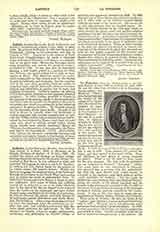

Lafleche , LOUIS-FRANCOIS RICHER, French-Canadian bishop, b. September 4, 1818, at Ste-Anne de la Perade, Province of Quebec; d. July 14, 1898. He studied the classics and theology at Nicolet College. Having offered his services to the pioneer Bishop Provencher of Red River, he was ordained in 1844, and traveled 750 leagues by canoe to reach St. Boniface. In 1846 he left with Father Tache for the mission of La Crosse island, 300 leagues distant. Besides the Sauteux language, he mastered those of the Crees and Montagnais prevalent in the North-West, and was the first to reduce the latter to grammatical form. In 1849 Pius IX preconized him Bishop of Arath in partibus infidelium. Five years of illness and suffering having left an infirmity in one of his limbs which he bore to the end of his life, he begged to be released from the burden of the episcopate and have Father Tache’s name substituted in the Bulls of nomination. In 1851 he directed the almost incredible defense of 60 half-breeds against 2000 Sioux near Turtle Mountain, North Dakota. After a siege of two days (13 and July 14), the assailants spied the missionary in surplice and stole, and withdrew, convinced that the Great Spirit protected the half-breeds. In 1856 he returned to Canada, where he taught mathematics, astronomy, and philosophy at Nicolet College, of which he was appointed president in 1859. In 1866 Bishop Cook of Three Rivers chose him for coadjutor, and in 1870, while at the Vatican Council, Bishop Lafleche succeeded to the vacant see. He was no less an able administrator than an eloquent orator. Besides his weekly sermons in his cathedral, where he often treated the great social and politico-religious questions of the day, his voice was heard on many important occasions. A dauntless exponent of Catholic truth and an ardent Ultramontane, his utterances were not always acceptable to the group of politicians who inclined towards Liberalism. When, in 1885, contrary to his wish, his diocese was divided, he bowed submissively to the decree of the Holy See, and soon beheld the loss partly repaired by the creation and development of several prosperous industrial centers. Besides five volumes of pastoral letters, Bishop Lafleche published the following works: “Quelques considerations sur les rapports de la societe civile avec la religion et la famille” (1866); “Conferences sur l’encyclique `Humanum Genus'”.
LIONEL LINDSAY

